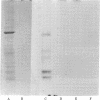Abstract
Acetylcholine receptor-phosphorylation has been compared in sealed and lysed right-side-out membrane vesicles prepared form Torpedo californica electric organ. Phosphorylation was increased 5- to 12-fold in hypotonically lysed vesicles as compared with untreated vesicles. Control experiments confirm that this enhancement is a result of increased permeability of the membrane to ATP. These data suggest that the acetylcholine receptor kinase is located on the cytoplasmic side of the plasma membrane. Results with detergent lysis support this conclusion. Although the acetylcholine receptor constitutes less than 10% of the total protein in these membranes, the kinase was found to be highly specific for polypeptides corresponding in molecular weight to acetylcholine receptor subunits.
Full text
PDF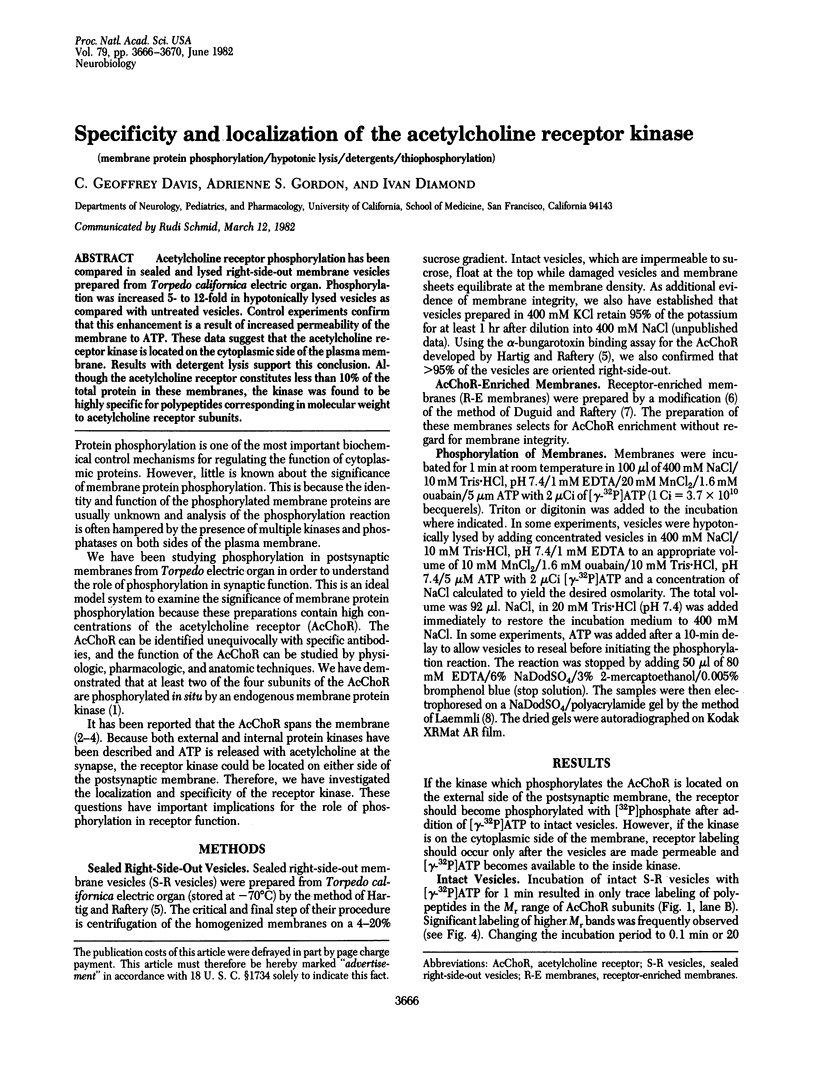
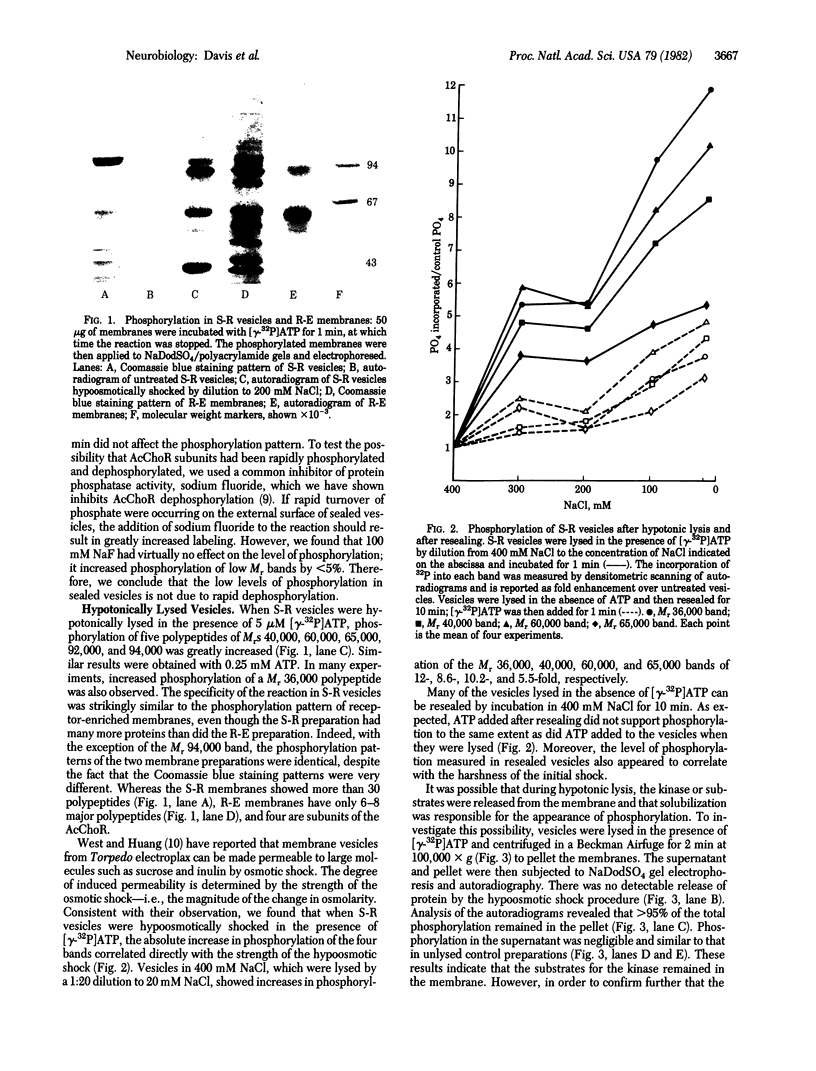
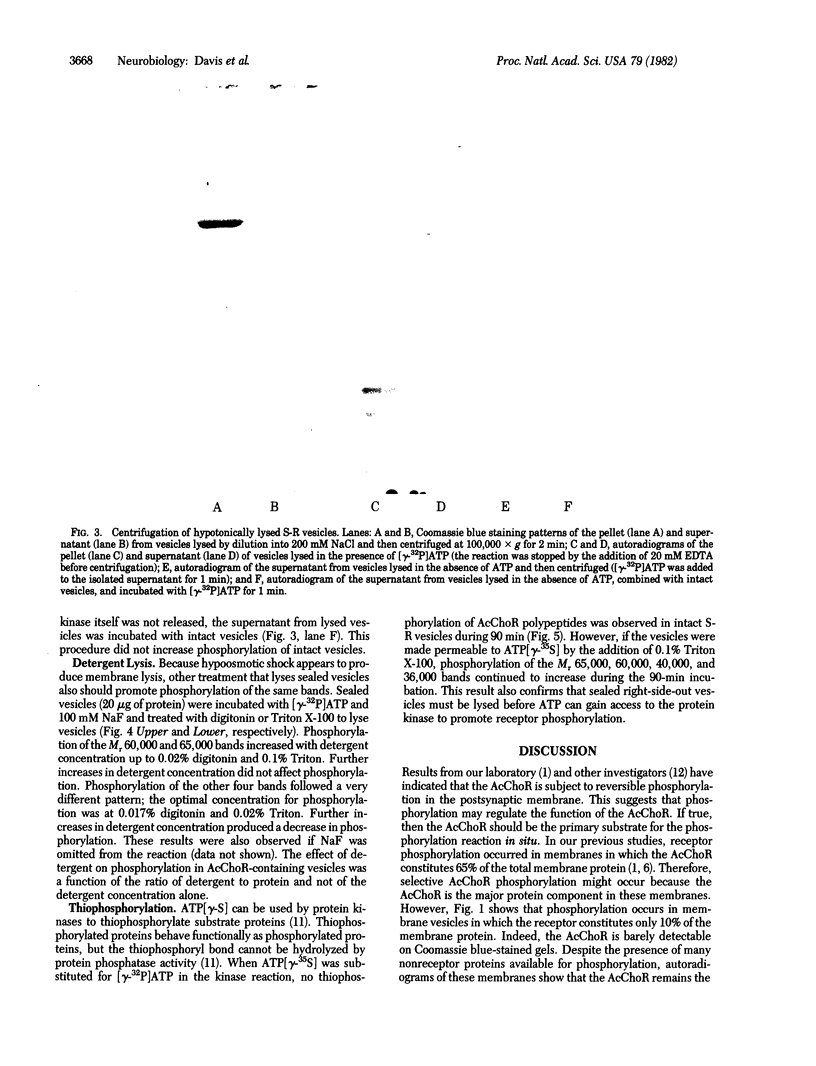
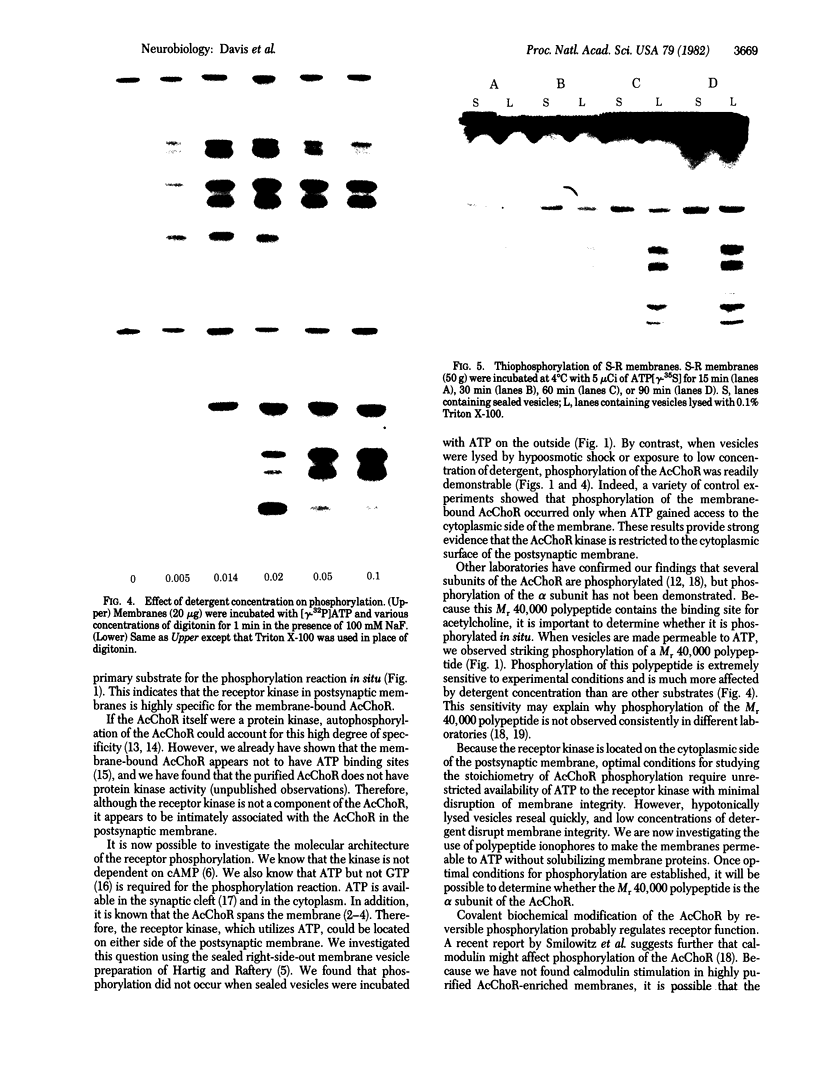
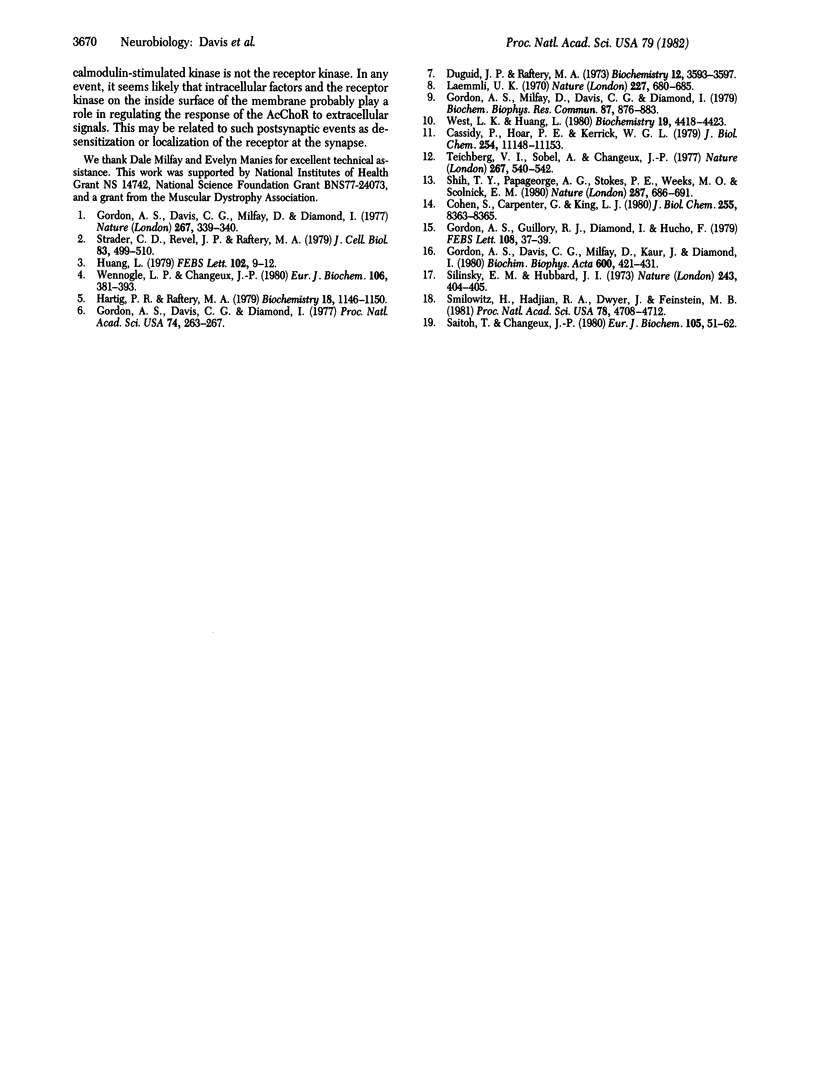
Images in this article
Selected References
These references are in PubMed. This may not be the complete list of references from this article.
- Cassidy P., Hoar P. E., Kerrick W. G. Irreversible thiophosphorylation and activation of tension in functionally skinned rabbit ileum strips by [35S]ATP gamma S. J Biol Chem. 1979 Nov 10;254(21):11148–11153. [PubMed] [Google Scholar]
- Duguid J. R., Raftery M. A. Fractionation and partial characterization of membrane particles from Torpedo californica electroplax. Biochemistry. 1973 Sep 11;12(19):3593–3597. doi: 10.1021/bi00743a003. [DOI] [PubMed] [Google Scholar]
- Gordon A. S., Davis C. G., Diamond I. Phosphorylation of membrane proteins at a cholinergic synapse. Proc Natl Acad Sci U S A. 1977 Jan;74(1):263–267. doi: 10.1073/pnas.74.1.263. [DOI] [PMC free article] [PubMed] [Google Scholar]
- Gordon A. S., Davis C. G., Milfay D., Kaur J., Diamond I. Membrane-bound protein kinase activity in acetylcholine receptor-enriched membranes. Biochim Biophys Acta. 1980 Aug 4;600(2):421–431. doi: 10.1016/0005-2736(80)90445-9. [DOI] [PubMed] [Google Scholar]
- Gordon A. S., Guillory R. J., Diamond I., Hucho F. ATP-binding proteins in acetylcholine receptor-enriched membranes. FEBS Lett. 1979 Dec 1;108(1):37–39. doi: 10.1016/0014-5793(79)81173-4. [DOI] [PubMed] [Google Scholar]
- Gordon A. S., Milfay D., Davis C. G., Diamond I. Protein phosphatase activity in acetylcholine receptor-enriched membranes. Biochem Biophys Res Commun. 1979 Apr 13;87(3):876–883. doi: 10.1016/0006-291x(79)92039-4. [DOI] [PubMed] [Google Scholar]
- Hartig P. R., Raftery M. A. Preparation of right-side-out, acetylcholine receptor enriched intact vesicles from Torpedo californica electroplaque membranes. Biochemistry. 1979 Apr 3;18(7):1146–1150. doi: 10.1021/bi00574a004. [DOI] [PubMed] [Google Scholar]
- Huang L. Transmembrane nature of acetylcholine receptor as evidenced by protease sensitivity. FEBS Lett. 1979 Jun 1;102(1):9–12. doi: 10.1016/0014-5793(79)80917-5. [DOI] [PubMed] [Google Scholar]
- Laemmli U. K. Cleavage of structural proteins during the assembly of the head of bacteriophage T4. Nature. 1970 Aug 15;227(5259):680–685. doi: 10.1038/227680a0. [DOI] [PubMed] [Google Scholar]
- Saitoh T., Changeux J. P. Phosphorylation in vitro of membrane fragments from Torpedo marmorata electric organ. Effect on membrane solubilization by detergents. Eur J Biochem. 1980 Mar;105(1):51–62. doi: 10.1111/j.1432-1033.1980.tb04473.x. [DOI] [PubMed] [Google Scholar]
- Shih T. Y., Papageorge A. G., Stokes P. E., Weeks M. O., Scolnick E. M. Guanine nucleotide-binding and autophosphorylating activities associated with the p21src protein of Harvey murine sarcoma virus. Nature. 1980 Oct 23;287(5784):686–691. doi: 10.1038/287686a0. [DOI] [PubMed] [Google Scholar]
- Silinsky E. M., Hubbard J. I. Thermal synthesis of amino acids from a simulated primitive atmosphere. Nature. 1973 Jun 15;243(5407):404–405. doi: 10.1038/243404a0. [DOI] [PubMed] [Google Scholar]
- Smilowitz H., Hadjian R. A., Dwyer J., Feinstein M. B. Regulation of acetylcholine receptor phosphorylation by calcium and calmodulin. Proc Natl Acad Sci U S A. 1981 Aug;78(8):4708–4712. doi: 10.1073/pnas.78.8.4708. [DOI] [PMC free article] [PubMed] [Google Scholar]
- Strader C. B., Revel J. P., Raftery M. A. Demonstration of the transmembrane nature of the acetylcholine receptor by labeling with anti-receptor antibodies. J Cell Biol. 1979 Nov;83(2 Pt 1):499–510. doi: 10.1083/jcb.83.2.499. [DOI] [PMC free article] [PubMed] [Google Scholar]
- Teichberg V. I., Sobel A., Changeux J. P. In vitro phosphorylation of the acetylcholine receptor. Nature. 1977 Jun 9;267(5611):540–542. doi: 10.1038/267540a0. [DOI] [PubMed] [Google Scholar]
- Ushiro H., Cohen S. Identification of phosphotyrosine as a product of epidermal growth factor-activated protein kinase in A-431 cell membranes. J Biol Chem. 1980 Sep 25;255(18):8363–8365. [PubMed] [Google Scholar]
- Wennogle L. P., Changeux J. P. Transmembrane orientation of proteins present in acetylcholine receptor-rich membranes from Torpedo marmorata studied by selective proteolysis. Eur J Biochem. 1980 May;106(2):381–393. doi: 10.1111/j.1432-1033.1980.tb04584.x. [DOI] [PubMed] [Google Scholar]
- West L. K., Huang L. Transient permeabilization induced osmotically in membrane vesicles from Torpedo electroplax: a mild procedure for trapping small molecules. Biochemistry. 1980 Sep 16;19(19):4418–4423. doi: 10.1021/bi00560a006. [DOI] [PubMed] [Google Scholar]




